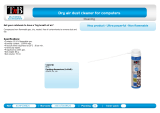
TABLE OF CONTENTS
Important Information ...................................................................................... 3
Warranty .......................................................................................................... 3
Contact Information ......................................................................................... 3
Introduction ...................................................................................................... 5
Spectral Sensitivity Range ........................................................................... 5
Locate Detector ........................................................................................... 5
Typical applications ..................................................................................... 5
Potential ignition sources ............................................................................. 5
Potential inhibitors ....................................................................................... 6
Absorbing Gases ......................................................................................... 6
Immune ........................................................................................................ 6
Range .............................................................................................................. 6
Field of View (as per FM and NFPA definition) ............................................... 7
Installation Considerations .............................................................................. 7
Unpack ............................................................................................................ 8
Reflector Positioning ....................................................................................... 9
Field Installation ............................................................................................ 10
Wiring ......................................................................................................... 10
Grounding .................................................................................................. 10
Sealing ....................................................................................................... 10
Connecting................................................................................................. 11
Detector Setup .............................................................................................. 13
System Sensitivity ..................................................................................... 13
DIP Switch Access ................................................................................. 13
Sensitivity Setting ................................................................................... 13
Time Delay Setting ................................................................................. 13
Closing the Housing ............................................................................... 14
Relay Settings ............................................................................................... 14
Coil and Latch Status ................................................................................ 14
Remote Reset ........................................................................................ 14
Final Setup ............................................................................................. 14
Detector Functionality ................................................................................... 15
Detector Window/Lens .............................................................................. 15
Start Up Procedure .................................................................................... 15
System Check ........................................................................................... 15
Monitor ....................................................................................................... 15
Condition Status—LEDs ........................................................................ 15
Condition Status—Current Output ......................................................... 16
Detector Maintenance ................................................................................... 17
Testing ....................................................................................................... 17
Manual Check Procedure .......................................................................... 17
Automatic Visual Integrity (VI) Test ........................................................... 17
Manual VI Test........................................................................................... 17
Test Procedure....................................................................................... 18
Cleaning Window/Lens and Reflector ........................................................... 19
O-ring ......................................................................................................... 19
How To Return Equipment ............................................................................ 20
Troubleshoot ................................................................................................. 21
Appendix A: Common UV Absorbing Gases ................................................ 22
Appendix B: Electrostatic Sensitive Device (ESD) ........................................ 23
Appendix C: Resistance Table ...................................................................... 24
Appendix D: Specifications ........................................................................... 25
Appendix E: UVIRS DATA ............................................................................ 26
Appendix E: UVIRS DATA (continued) ......................................................... 27




















